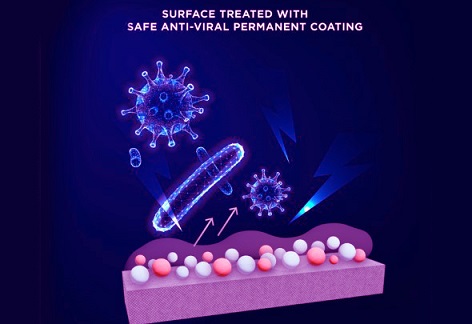Nikhil Prasad Fact checked by:Thailand Medical News Team Oct 27, 2024 1 year, 1 month, 1 week, 2 days, 10 hours, 5 minutes ago
COVID-19 News: Innovative Virus-Fighting Surfaces Created
Scientists have developed special coatings that can kill the SARS-CoV-2 virus, which causes COVID-19, when it comes into contact with surfaces. These coatings, designed using powerful disinfectants called quaternary ammonium compounds, could be the key to reducing the spread of the virus in public places. Researchers from three leading institutions - the Institute of Organoelement Compounds, Gamaleya National Research Center for Epidemiology and Microbiology, and Moscow State University in Russia - have worked together to create these groundbreaking solutions.
 Russia develops new anti-COVID coatings to help stop the spread of SARS-CoV-2
Russia develops new anti-COVID coatings to help stop the spread of SARS-CoV-2
This
COVID-19 News reports on a new study that looked at three types of coatings: those that kill viruses on contact, those that release disinfectants over time, and coatings that do both. These coatings were tested to see how well they could inactivate the virus, and the results were promising.
What Are These Coatings and How Do They Work?
The scientists behind this study developed three kinds of coatings that could be applied to common surfaces like glass and silicon, which are often found in everyday settings such as hospitals, public transport, or office buildings. The main active ingredient used in these coatings is quaternary ammonium compounds, which are well-known disinfectants commonly found in cleaning products.
The coatings work in two main ways. The contact-based coatings are designed to kill the virus immediately when it touches the surface. These coatings are bonded tightly to the surface so that the virus is instantly attacked and destroyed. The second type, release-based coatings, gradually release disinfectants over time, providing long-lasting protection by slowly killing the virus. The third type of coating combines both these methods, offering double protection by killing the virus on contact and continuing to release disinfectants for a longer time.
How Effective Are These Coatings?
The study showed that the most effective coatings were those that combined contact-based and release-based actions. These coatings completely inactivated the SARS-CoV-2 virus. In contrast, coatings that relied only on contact-based actions, where disinfectants were chemically bonded to the surface, were less effective. The contact-based coatings reduced the amount of virus by 1.25 log10, which was a significant reduction but not complete inactivation.
The researchers found that using both methods together made the coatings far more powerful in killing the virus. Interestingly, there wasn’t a big difference between flat surfaces and structured surfaces, meaning that the virus-fighting ability of the coatings worked similarly, no matter the texture of the surface.
Why Is This Important?
Surface contamination is one of the ways the virus spreads. When an infected person coughs or sneezes, the virus can land on nearby surfaces. If someone el
se touches these contaminated surfaces and then touches their face, they could catch the virus. Reducing the number of infectious particles on surfaces can play a huge role in preventing the spread of diseases like COVID-19.
What makes these coatings particularly promising is their ability to work continuously, unlike regular disinfectants that only work for a short time after application. The release-based action ensures that surfaces remain safe for longer, reducing the need for frequent cleaning, which could save time, effort, and resources.
Testing the Coatings
The study tested these coatings in a laboratory environment, applying them to different materials such as glass and silicon, which are commonly used in public spaces. The researchers applied the coatings to these materials and then exposed them to SARS-CoV-2, measuring how much of the virus remained active afterward.
The results were clear: surfaces that had both contact-based and release-based coatings completely inactivated the virus, providing the highest level of protection. Even after a short period of exposure (just five minutes), the virus was entirely inactivated on these surfaces. The researchers also tested different concentrations of the disinfectants and found that higher concentrations worked better, as expected.
Practical Applications of These Findings
Imagine a hospital or a busy office building where high-touch surfaces like door handles or elevator buttons are coated with these special virus-killing coatings. These surfaces could actively reduce the spread of SARS-CoV-2, protecting both staff and visitors. The fact that the coatings keep working over time means that these places wouldn’t need to be cleaned as frequently, providing an extra layer of safety.
Moreover, the study showed that surfaces like plastic and metal, which can harbor the virus for several days, could be made much safer by applying these new coatings. This technology could also help in other areas, such as schools, airports, and public transport, where the risk of surface transmission is high.
What Does This Mean for the Future?
The development of these coatings could represent a big step forward in our fight against COVID-19 and similar viruses. While vaccines are essential in controlling the pandemic, having an extra layer of defense through virus-inactivating surfaces could help stop the spread in areas where cleaning is not always possible or immediate.
The next step for the researchers is to test these coatings in real-world environments, such as hospitals or other public spaces. If these tests are successful, we could soon see virus-killing surfaces become a common feature in high-risk areas.
Conclusion
This new technology could help control the spread of COVID-19 and other viruses in public spaces. By combining two methods - contact-based and release-based – these coatings provide a powerful way to inactivate the virus on surfaces, offering long-lasting protection. While more testing is needed in real-world settings, the results so far are promising, and this technology could become a key part of our fight against viral infections.
The study findings were published in the peer-reviewed journal: Molecules.
https://www.mdpi.com/1420-3049/29/20/4961
For the latest
COVID-19 News, keep on logging to Thailand Medical News.
Read Also:
https://www.thailandmedical.news/news/covid-19-disinfectants-pacific-northwest-national-laboratory-invents-antiviral-superhydrophobic-coating-for-healthcare-usage-such-as-on-ppes,-gloves-e
https://www.thailandmedical.news/news/breaking-covid-19-disinfectants-warning-about-dangers-of-quat-quaternary-ammonium-compounds-disinfectants-currently-being-used
https://www.thailandmedical.news/news/study-shows-that-disinfectants-containing-benzalkonium-chloride-can-give-rise-to-drug-resistant-microbes
